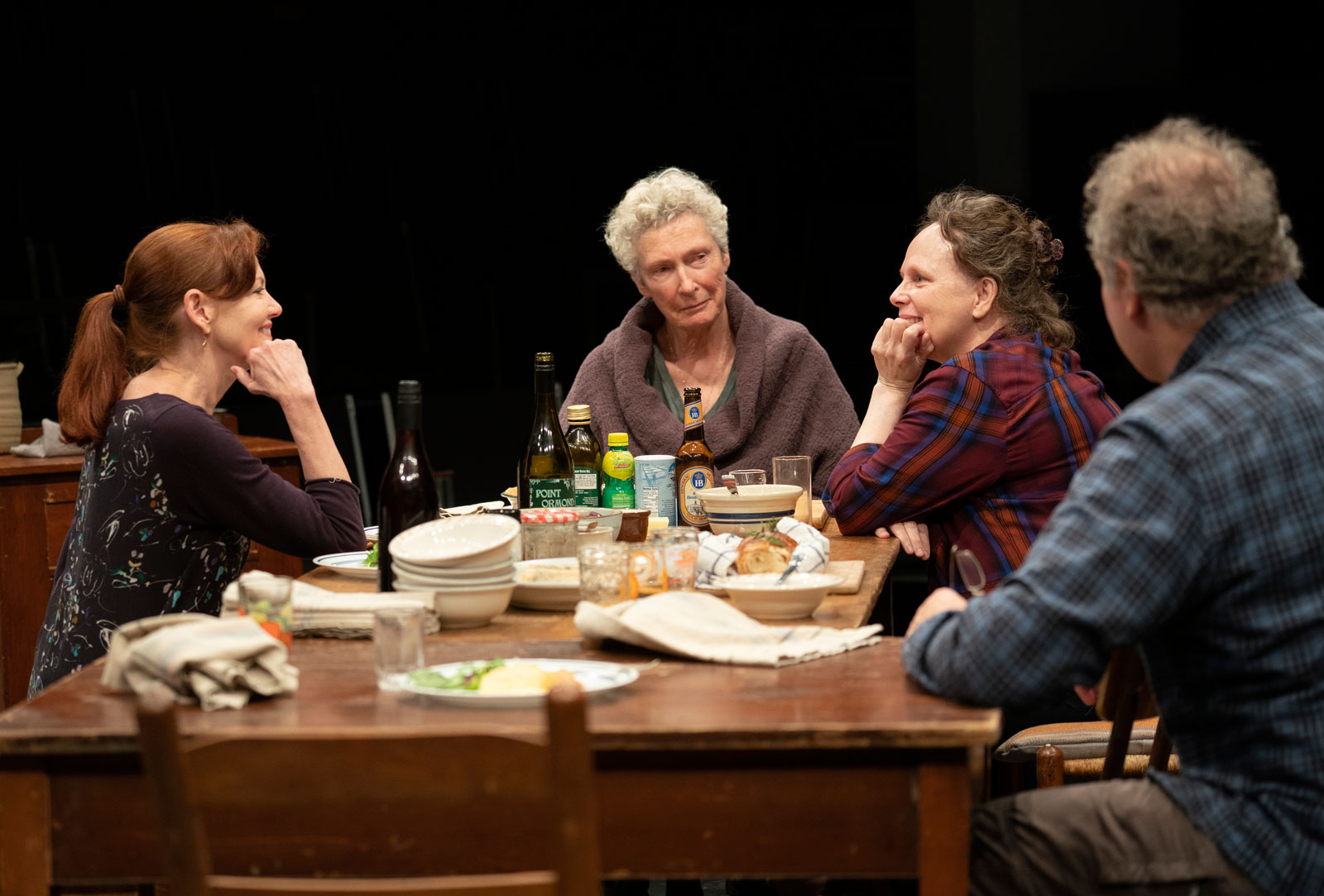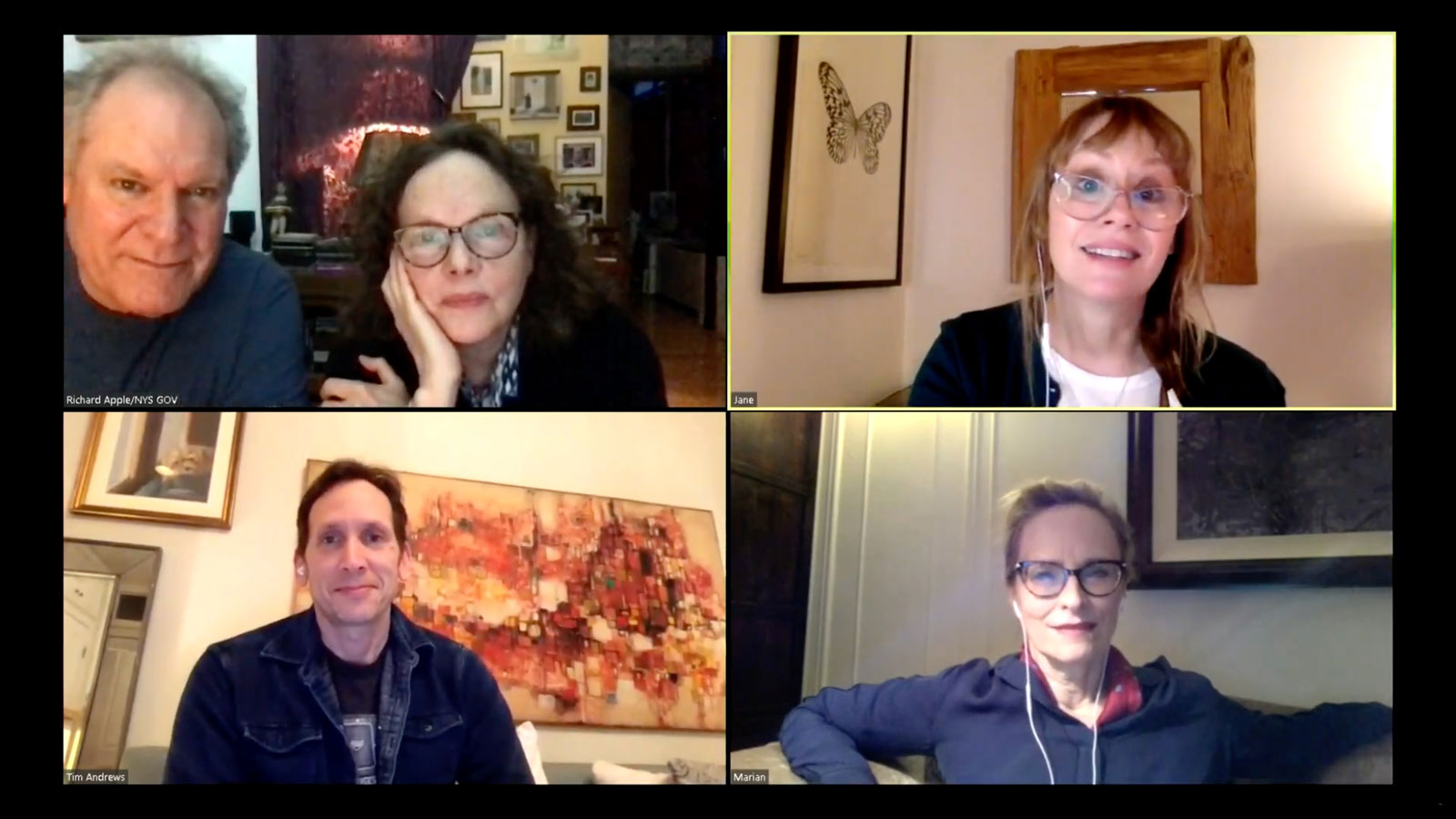“There are certain parts of women’s lives that have never, ever been danced,” says Rose Michael, a character in Richard Nelson’s recent play The Michaels. A choreographer in her mid-sixties with stage-four ovarian cancer, Rose (Brenda Wehle) is thinking about her legacy. She comes out of the tradition of Anna Halprin and Yvonne Rainer and favors dance that isn’t “dancy,” as she calls it, dance that glorifies regular movements, the more quotidian the better. She envisions her last commission, which she still hopes to complete, as a group of women “sentenced to endless mundane tasks…carrying a jug of water. Emptying it. Filling it up again, again, and again. Doing laundry. Washing a floor, cooking. The gods think they have punished these women to a kind of hell, but the women…will turn these mundane tasks into graceful, beautiful gestures.”
I saw The Michaels last November at the Public Theater in New York City. It’s the eighth entry in Nelson’s continuing “Rhinebeck Panorama,” a cycle of plays set upstate, in which Nelson observes three different families, the Apples, the Gabriels, and Michaels, going through ordinary, mundane moments—which, of course, are never entirely ordinary or mundane. Like the other plays in the cycle, The Michaels—itself the first of a projected two-part series—takes place the night it opened (Sunday, October 27, 2019). Rose’s extended family has gathered in her farmhouse kitchen to talk about her condition. Her daughter, Lucy, and her niece, May, have been rehearsing some of Rose’s early dances for an upcoming retrospective. Her ex-husband, David, is accompanied by his wife, Sally, who used to dance with Rose, and Irenie, another former dancer, who has just arrived from the city to coach Lucy and May. Rose’s new partner, Kate, prepares quiche for everyone. As in Nelson’s other plays, the set has an oven and a sink with running water and the actors actually cook dinner.
Rose is the center, the star and the heart of this family, the person whose moods and humors have to be gauged, whose silences and behaviors have to be interpreted. At first, conversation is slow, a bit awkward. The characters speak mostly of dance. They reminisce and explain and correct each other, trying to include Kate, a retired schoolteacher, in their world. They quote Merce Cunningham and tell stories about Martha Graham and Paul Taylor. All the while, amid the unpacking of groceries and food prep and reminiscing, the group addresses in gingerly fashion the subject of Rose’s cancer. Will Kate be Rose’s caretaker in her last months? Will Rose be able to finish her final project? Should Lucy go to France for a months-long dance residency?
Nelson’s play is subtitled “Conversations During Difficult Times” but it’s every bit as much about what goes unsaid. The quiche gets made, photographs are looked through, notebooks read, cigarettes smoked (off stage). Rose leaves the room to take a nap. Rose comes back. And two thirds of the way through the evening, something marvelous happens: the girls cue up Scott Joplin’s “Maple Leaf Rag” and Lucy begins to dance.
It’s a surprising moment. Even as the characters talked about dance and then began to move the chairs around to make room for some, I didn’t really expect to see dancing. Or rather, I didn’t expect to see real dancing. I thought we’d see a suggestion of it—but here Lucy, played by Charlotte Bydwell, erupts into full-on modern dance. The piece she performs, one of Rose’s, was actually created in the 1970s by Dan Wagoner, a renowned choreographer from West Virginia who danced with Martha Graham and Paul Taylor before forming his own company. When Anna Kisselgoff reviewed it in The New York Times in 1977, she described its movements as “dog paddle, fly swatting, pelvis wiggle, shoulder jerking, walking, head and arm flinging and a final stamping to the beat.”
It’s a charming, delightful dance, as are the others that follow. Bydwell is a dancer as well as an actress, and so is Matilda Sakamoto, who plays May. (In all, Bydwell and Sakamoto perform three dances within the play, two solos and a duet, each of which was adapted for The Michaels by Gwyneth Jones, a former dancer in Wagoner’s company.) This dance, made by a man and used to represent the work of a fictitious female choreographer, doesn’t look like what I imagined Rose would make. And yet the actual dancing—its liveliness and ephemeral nature—poignantly underscored the themes of the play: the imminence of death and how we make sense of a life.
Advertisement
All these months later, as we go about our pandemic days, waiting to be out in the world again, I think about that moment when Lucy began to dance, an ordinary moment that cracked open and allowed an extraordinary grace to emerge. It’s helped me mourn all that we are missing: the live performances we can’t attend because there are none, the lost jobs, the out-of-work performers, the struggling institutions. And, of course, the dead.
But something remarkable has begun to happen. Online, museums post curator talks. Dance companies make vintage footage available. Choreographers offer free dance classes to emergency workers. Musicians sheltering at home are live-streaming concerts. The Ballet de l’Opéra national de Paris has produced a spectacularly clever and affecting video showing its dancers practicing and performing exquisite movements in mundane places: living rooms, kitchens, stairwells, balconies, bubble baths.
Richard Nelson, too, has adapted to the crisis: he has written a new play, commissioned by the Public Theater, that live-streamed in late April. What Do We Need to Talk About? had the four siblings of the Apple family—last seen in 2014—and a partner on a Zoom call. A little spooked, but happy to see one another, the characters discuss quarantine, the etiquette of masks, the perils of shopping, and the oldest sister Barbara’s hospitalization and recovery from the coronavirus. They turn to art, too. Barbara (Maryann Plunkett, who, along with her real-life husband, Jay O. Sanders, has appeared in every installment of the cycle) uses her phone to play a recording of Walt Whitman’s poem “The Wound-Dresser,” and then a section of Bach’s Mass in B Minor. Reliably, heartbreakingly, artists are making new work that pushes the limits of what’s possible right now. As one character says to another at the end of Nelson’s new play, “We should do it again. Tomorrow night?”
The Michaels, written and directed by Richard Nelson, was performed at the Public Theater, New York City, October 19–December 1, 2019. Nelson’s new play, What Do We Need to Talk About?, is streaming on demand on the Public Theater’s website through June 28.





